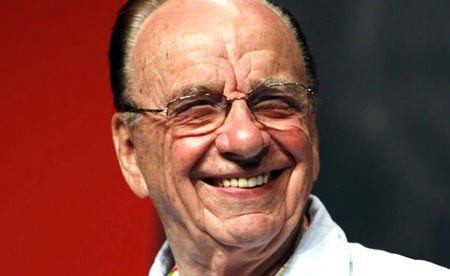
Over the past few weeks, one public media company after another has reported quarterly numbers to shareholders and, with the exception of a few sad-sacks (AOL and the AP, to name two), the results have been generally positive.
Advertisers are buying space on television, online — even in print. Consumers are actually buying things, like iPads and movie tickets.
COOs using unfamiliar terms like "dividends" and "profits."
News Corp., CBS Corp., Time Warner and Viacom all reported better-than-expected quarterly earnings driven by an ad rebound (and, in News Corp.’s case, “Avatar”). At CBS — where advertising represents nearly two-thirds of its revenue — ad sales grew 17 percent. (According to Bloomberg, News Corp., CBS Corp. and Viacom are all mulling dividend increases or share buybacks “as an advertising rebound spurs cash flow.”)
Even the New York Times reported a profit swing helped, in part, by an 18 percent boost in digital advertising.
"We’re seeing demand come back both at our networks and our publishing," Time Warner chief Jeff Bewkes said during a conference call with investors earlier this month, touting, among other things, Time Inc.’s first quarter of ad growth in more than two years.
Add to that reports of a hiring thaw and generally brighter advertising outlook, and it adds up to what appears to be — get ready for it — a media industry recovery.
Could what everybody’s been waiting for, and it may — really, truly, finally — be here?
If it is, why isn’t everybody talking about it?
One reason could be: it’s still very new. Tangible signs – beyond quarterly earnings reports — of the recovery are just beginning to appear.
Just last week, the Big Four broadcast networks said they expected to take in about $9 billion in primetime ad dollars during this year’s annual upfronts, recouping the $2 billion they lost in the middle of last year’s economic downturn.
"There is no gloom and doom about broadcast television advertising this year," one network sales executive told TheWrap. "The media buying community is not talking about price decreases and tough times this year because they know such posturing is not going to help them.”
But they’re not necessarily talking about a full-blown recovery.
“There’s a cautious optimism,” said Roberta Garfinkle, director and SVP at TargetCast. “People are starting to release funds, and buying into places they weren’t a year ago.”
Viacom CEO Philippe Dauman said the “advertising market is showing signs of strength” last month before the company’s earnings call. “Our ad revenues moved into positive territory and are continuing that upward trend.” (Read: "Proceed with caution.")
"Companies are just now beginning to see the ‘positive’ results of the cost-cutting measures they’ve taken over the last 12 months or so," said Jason Fell, a senior editor at Folio.
And then there are the hard numbers. The bleeding has slowed in the advertising market, but has not stopped completely. In the magazine business, for instance, ad pages fell 9.4 percent during the first quarter – in normal years a bad result, but far better than the 26 percent slide in 2009.
“My favorite thing is when I hear [publishers] say advertising is up,” Garfinkle said. “I’ll say ‘Yeah, up from what base?’”
But there’s also something the consumer magazine industry hasn’t had in awhile: hope.
“It’s June, and people are starting to buy for the fall,” Garfinkle said. “There’s cautious optimism that this year is going to be better than last year. Does that mean ‘it’s over’ and ‘we’ve recovered’? No. But it’s getting better.”
“It looked like, a year ago March, that no one was going to advertise again,” Soleil Securities analyst Alan Gould told Bloomberg.
There’s also the fact that the layoffs that defined the last two or years in the media business have slowed, to be sure — but are not entirely over. Last month, for example, ABC News laid off 22 employees, the final step in a round of more than 350 cuts – or roughly 25 percent — at the network. Meanwhile, Playboy magazine – already decimated by layoffs — has said it may have to cut more, even as it plans digital hires.
Added Fell: "I think there will be more that will fold because their model can’t sustain their business going forward." (Newsweek, all eyes are on you.)
Then there’s the “Avatar” effect. News Corp.’s profit soared 55 percent to $1.25 billion during the quarter – the first to count receipts from James Cameron’s blockbuster. Similarly, profits at Disney (“Alice in Wonderland”) and TW (“Sherlock Holmes” on DVD) benefited from box office smashes. Without them, the financial picture at those companies would be a lot different.
Another, less tangible reason for the lack of recovery chatter: nerves. News Corp. chief Rupert Murdoch said that the company had been “nervous” about using its available cash during the last year, but there is a “growing air of confidence.”
Still, as one media onlooker put it: “Don’t be seduced by some of these quarterly numbers – we’re coming off some easy comps,” something Murdoch himself has been quick to point out during earnings calls with investors.
"The ‘recovery’ that is happening isn’t widespread and definitely isn’t dramatic," Fell said. "I think media companies are reluctant to wave any victory flags until a recovery is substantive and of a healthy duration."
CBS chief Les Moonves put it another way in his investor call: “Stay tuned.”
More to read:
Time Warner Profit Up 10% on Ad Recovery, ‘Holmes’ Video
News Corp. Profit Soars on Back of ‘Avatar’
Viacom Profit Rises on Ad Rebound
News Corp. Profit Soars on Back of ‘Avatar’
Viacom Profit Rises on Ad Rebound
